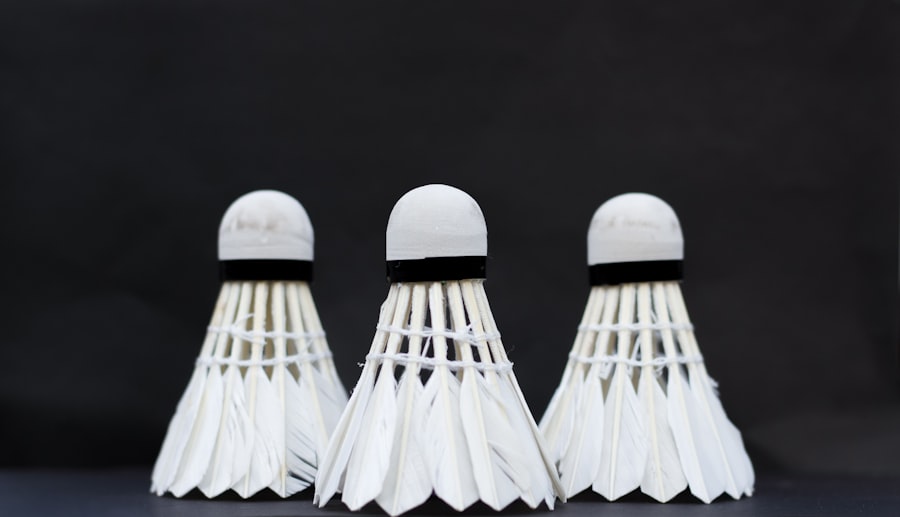Mastering the Art of Badminton: Tips for Success
Description
Badminton is a fast-paced racquet sport that has gained immense popularity worldwide, characterized by its unique blend of agility, strategy, and precision. The game is played with a shuttlecock, which is a feathered projectile that players hit back and forth over a net. The objective is to score points by landing the shuttlecock in the opponent’s court while preventing them from doing the same.
Badminton can be played in singles or doubles formats, each requiring different strategies and skills. The court dimensions, which are 13.4 meters long and 6.1 meters wide for doubles, and 5.18 meters wide for singles, create a dynamic playing environment that demands quick reflexes and strategic thinking. The origins of badminton can be traced back to ancient civilizations, but it was formalized in the mid-19th century in England.
The Badminton Association of England was established in 1877, and the first set of rules was published shortly thereafter. The sport has since evolved into an Olympic event, with countries like China, Indonesia, and Denmark dominating the international scene.
For instance, matches are typically played to 21 points, with players needing to win by a margin of two points. This scoring system adds an element of strategy, as players must balance aggression with caution to secure their victories.
Key Takeaways
- Badminton is a fast-paced racket sport played with a shuttlecock, requiring agility and precision.
- Footwork and movement are crucial in badminton, as they allow players to reach the shuttlecock and maintain control on the court.
- Developing a strong grip and mastering racket control are essential for executing powerful and accurate shots in badminton.
- There are various types of badminton shots, including the clear, drop shot, smash, and drive, each serving different purposes during a game.
- Improving serve and return techniques is important for gaining an advantage over opponents and setting the tone of the game.
Perfecting Your Footwork and Movement on the Court
Footwork is arguably one of the most critical aspects of badminton, as it directly influences a player’s ability to reach the shuttlecock effectively and execute shots with precision. Good footwork allows players to maintain balance while moving quickly across the court, enabling them to respond to their opponent’s shots efficiently. The foundation of effective footwork lies in mastering the basic movements: the split step, lunges, and side shuffles.
The split step is particularly important as it prepares players to move in any direction as soon as their opponent strikes the shuttlecock. To enhance footwork, players should focus on developing a strong base through proper stance and posture. Keeping the feet shoulder-width apart and knees slightly bent allows for better stability and quicker reactions.
Practicing drills that emphasize lateral movement and quick changes of direction can significantly improve agility on the court. For example, shadow badminton drills—where players mimic game movements without a shuttlecock—can help reinforce muscle memory and improve overall movement efficiency. Additionally, incorporating agility ladders or cones into training routines can further enhance foot speed and coordination.
Developing Your Grip and Racket Control

The grip is a fundamental aspect of badminton that significantly affects a player’s performance.
There are two primary grips used in badminton: the forehand grip and the backhand grip. The forehand grip is typically used for most shots, while the backhand grip is essential for executing shots on the opposite side of the body. To achieve a proper forehand grip, players should hold the racket as if shaking hands with it, ensuring that the thumb is placed flat against the back of the handle for added support.
Racket control is closely tied to grip technique; it allows players to manipulate the shuttlecock’s trajectory and spin effectively. Practicing various drills that focus on racket handling can help players develop better control. For instance, players can practice hitting against a wall to improve their accuracy and consistency.
By varying the distance from the wall and adjusting shot types—such as clears, drops, and smashes—players can refine their touch and feel for the racket. Additionally, understanding how to adjust grip pressure based on shot requirements can lead to more effective play; a firmer grip may be necessary for powerful smashes, while a lighter grip can facilitate delicate drop shots.
Mastering the Different Types of Badminton Shots
| Shot Type | Description |
|---|---|
| Clear | A shot hit high and to the back of the opponent’s court, used to force the opponent to the back of the court. |
| Drop Shot | A shot hit softly and close to the net, used to catch the opponent off guard. |
| Smash | A powerful shot hit downwards, used to finish off a point or to put pressure on the opponent. |
| Drive | A fast and flat shot hit parallel to the ground, used to keep the opponent on the defensive. |
| Net Shot | A shot hit close to the net, used to create an opportunity for a follow-up shot or to control the pace of the game. |
A well-rounded badminton player must be proficient in executing various types of shots, each serving a specific purpose during gameplay. The fundamental shots include clears, drops, smashes, drives, and net shots. The clear shot is used to send the shuttlecock high and deep into the opponent’s court, allowing players time to reposition themselves.
It is essential for defensive play and can also set up offensive opportunities by pushing opponents to the back of their court. The drop shot, on the other hand, is a delicate maneuver designed to land just over the net in the opponent’s front court. This shot requires finesse and precision; it can catch opponents off guard if executed correctly.
Smashes are powerful downward strikes aimed at overwhelming opponents with speed and force; mastering this shot involves not only strength but also timing and positioning. Drives are fast-paced shots that travel horizontally over the net, often used in fast exchanges during rallies. Finally, net shots are crucial for controlling play at the front of the court; they require quick reflexes and excellent touch to execute effectively.
Improving Your Serve and Return Techniques
Serving is one of the most critical aspects of badminton as it initiates each rally and sets the tone for subsequent exchanges. A well-executed serve can put immediate pressure on opponents while providing an opportunity for offensive play right from the start. There are two primary types of serves: high serves and low serves.
High serves are typically used in singles play to push opponents back, while low serves are more common in doubles play to create opportunities for quick attacks at the net. To improve serving techniques, players should focus on consistency and placement rather than sheer power. Practicing serves from different positions on the court can help players develop a versatile serving strategy that keeps opponents guessing.
Additionally, understanding how to vary spin on serves can add an extra layer of complexity; a serve with topspin may bounce higher than expected, while a backspin serve may drop quickly after crossing the net. Return techniques are equally important as they determine how effectively a player can respond to an opponent’s serve. Players should aim to anticipate their opponent’s serve type and position themselves accordingly.
Practicing various return drills can help players develop quick reflexes and improve their ability to counter different serve styles effectively. For instance, practicing returns against high serves can help players learn how to execute powerful clears or aggressive smashes immediately after receiving serve.
Enhancing Your Speed and Agility

Speed and agility are paramount in badminton due to the sport’s fast-paced nature. Players must be able to move quickly around the court while maintaining control over their body movements to respond effectively to their opponent’s shots. To enhance speed, players should incorporate sprinting drills into their training regimen; short bursts of speed mimic the quick movements required during matches.
Interval training can also be beneficial; alternating between high-intensity sprints and recovery periods helps build both speed and endurance. Agility training focuses on improving coordination and balance through various exercises that challenge a player’s ability to change direction quickly. Ladder drills are particularly effective for enhancing foot speed and coordination; they require players to navigate through a series of rungs while maintaining control over their movements.
Plyometric exercises such as box jumps or lateral hops can also contribute significantly to developing explosive power necessary for quick movements on the court. Incorporating sport-specific drills into training routines can further enhance speed and agility relevant to badminton gameplay. For example, practicing footwork patterns that simulate match scenarios allows players to develop muscle memory while improving their overall movement efficiency during actual games.
Strategies for Playing Singles and Doubles Matches
The strategies employed in singles matches differ significantly from those used in doubles play due to variations in court coverage and player dynamics. In singles matches, players often focus on controlling the center of the court while utilizing a combination of clears, drops, and smashes to dictate play tempo. A common strategy involves forcing opponents into uncomfortable positions by alternating between deep clears and short drops; this keeps them guessing while creating opportunities for offensive shots.
In contrast, doubles play requires a more collaborative approach between partners; communication becomes essential for effective court coverage. Teams often adopt formations such as side-by-side or front-and-back positioning based on their strengths and weaknesses. A common strategy in doubles involves one player taking charge at the net while the other covers deeper shots; this allows for quick interceptions of weak returns while maintaining pressure on opponents.
Understanding when to switch roles during rallies is crucial in doubles play; effective communication ensures that both partners remain aware of each other’s positioning and intentions throughout exchanges. Practicing specific doubles drills that emphasize teamwork can help partners develop synergy on the court while refining their individual skills.
Mental and Physical Conditioning for Badminton Success
Mental conditioning plays an equally vital role in achieving success in badminton as physical training does. Players must cultivate mental resilience to handle pressure during matches effectively; this includes developing focus, confidence, and strategic thinking skills. Visualization techniques can be beneficial; imagining successful plays or positive outcomes helps reinforce confidence levels before stepping onto the court.
Additionally, mindfulness practices such as meditation or breathing exercises can aid in maintaining composure during high-stress situations within matches. Players should also work on developing a pre-match routine that helps them mentally prepare for competition; this could involve specific warm-up exercises or visualization techniques tailored to individual preferences. Physical conditioning encompasses not only strength training but also flexibility exercises that enhance overall performance on the court.
Incorporating strength training routines targeting core muscles improves stability during dynamic movements while enhancing shot power. Flexibility exercises such as yoga or dynamic stretching routines help prevent injuries while promoting better range of motion essential for executing various shots effectively. By focusing on both mental fortitude and physical conditioning, badminton players can create a comprehensive training regimen that prepares them for success at all levels of competition.
If you’re a fan of Badminton, you may also be interested in checking out this article about the latest Monopoly APK version 1.9.14 with unlocked features here. This game offers a fun and strategic twist on the classic board game, providing hours of entertainment for players of all ages. Whether you’re a beginner or a seasoned pro, Monopoly is sure to keep you engaged and challenged.
FAQs
What is badminton?
Badminton is a racquet sport played by either two opposing players (singles) or two opposing pairs (doubles), who take positions on opposite halves of a rectangular court divided by a net.
What equipment is used in badminton?
The primary equipment used in badminton includes a shuttlecock (also known as a birdie), badminton racquets, and a net. Players also wear appropriate footwear for the sport.
What are the basic rules of badminton?
The basic rules of badminton include serving diagonally, scoring points by landing the shuttlecock within the opponent’s court, and winning a match by winning two out of three games.
What are the health benefits of playing badminton?
Playing badminton can provide various health benefits, including improved cardiovascular fitness, agility, flexibility, and hand-eye coordination. It also helps in burning calories and promoting overall physical well-being.
What are the different types of badminton shots?
Some of the different types of badminton shots include the clear, drop shot, smash, drive, and the backhand shot. Each shot has its own specific technique and purpose during a game.
What are the different types of badminton tournaments?
There are various types of badminton tournaments, including local, national, and international competitions. The most prestigious international tournaments include the All England Open, BWF World Championships, and the Olympic Games.





